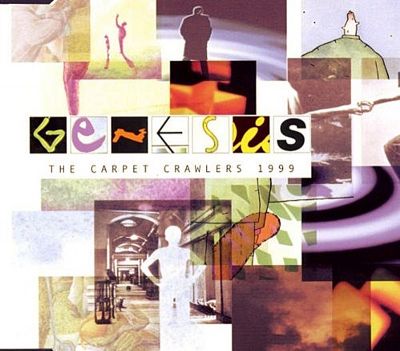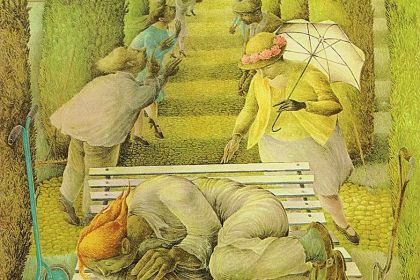SONGWRITER
Carpet Crawlers: two major modes of Genesis' last studio recording

The Carpet Crawlers LP cover
The Carpet Crawlers is an iconic song by the English progressive rock band Genesis recorded for their 1974 concept double album The Lamb Lies Down on Broadway and released as a single the following year. The track is one of the band's frontman Peter Gabriel's favorite pieces who, having grown disenchanted with the music industry, decided to leave Genesis immediately after touring in support of the album.
The cryptic song lyrics—written by Gabriel to reflect the album's concept—describe the so-called crawlers swarming the floor of a red corridor. These creatures are said to be travelling to a massive wooden door as they "got to get in to get out".
Curiously, a quarter of a century after the song's initial release, the band reunited in its original line-up of Peter Gabriel, Tony Banks, Mike Rutherford, Phil Collins, and Steve Hackett to re-record the track under the title The Carpet Crawlers 1999 which is the last studio recording by any configuration of Genesis to date.
Listen to Carpet Crawlers by Genesis:
Compositionally, The Carpet Crawlers consists of three sections and generally follows the Ionian mode with some deviations in the intro and choruses. In the harmonic analysis of the verses' chord chains, the scale degrees (denoted with Roman numerals) show the simple two-chord progressions in the key of D major: D–Em or I–ii.
Here are the chord chains for each line of the chorus that combine Ionian and Mixolydian modes:
- F♯m or iii in Ionian mode;
- A–G or V–IV in Ionian mode;
- A–G or V–IV in Ionian mode;
- D–C–Em–D or I–VII–ii–I in Mixolydian mode.
The chorus opens with the F♯m mediant chord followed by a double-repeated sequence of the A dominant chord and the G subdominant chord that creates tension and anticipates the appearance of a tonic triad. At the beginning of the fourth line, the tension is resolved by the D tonic chord. However, the progression continues to intrigue the listener as the mode itself changes. Indeed, the entire progression of the fourth line—together with the G subdominant chord that concludes the third line—can be confidently attributed to the Mixolydian major mode. Here it is the most prominent as the VII major subtonic chord.
The harmonic progressions accompanying the Carpet Crawlers intro follows E Mixolydian and contains a modulation that shifts the tonal center to D Ionian:
- Emaj7–Amaj7–Emaj7–Amaj7–F♯m–C♯ or I7–IV7– I7–IV7–ii–VI;
- C♯m–Dmaj7–C♯m–Dmaj7–Bm–Dmaj7–Bm–A7–D or vi–VII7–vi–VII7–v–VII7–v–IV(V)–I.
Note that the new key of D major is classically established by the A7–D authentic cadence. Marked in red, the C♯ chord does not belong to any of the three major diatonic modes (Ionian, Mixolydian, and Lydian) where the chord rooted in the sixth scale degree is a minor one and not major. Curiously, Genesis often chose to drop this intro in live performances after Gabriel's departure.
Learn more about the structure of these diatonic musical modes explained through the harmonic analysis of popular songs in the following articles:
- 7 songs featuring Mixolydian mode
- Mixolydian mode in The Doors songs
- The Bells of Rhymney: two major modal modes of famous protest song
- Seven Seas of Rhye: song of imaginary land brought to life by Ionian and Mixolydian modes
- 6 songs to unpack Ionian mode and the major scale
- 9 Beatles songs that combine harmonic major with Ionian mode
- Pachelbel's Canon: the harmonic sequence that flooded pop music
- Reelin' In the Years: the tandem of effective lyrics and one of the best guitar solos of all time
- Cum On Feel the Noize: Slade's instant hit recipe
- D'yer Mak'er: meaning of Led Zeppelin's most controversial song
- Mariposa Traicionera: meaning and flamenco roots of Maná's top hit
- Sugaree: Jerry Garcia's song referencing his lyricist's criminal past



